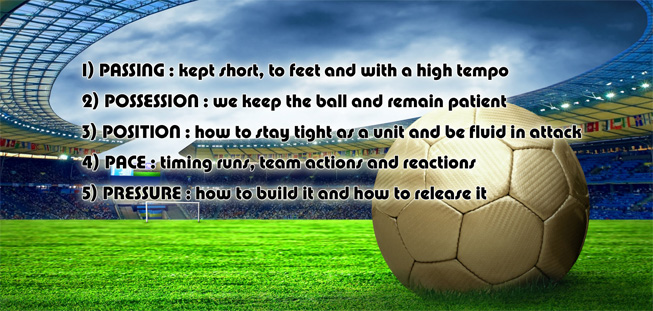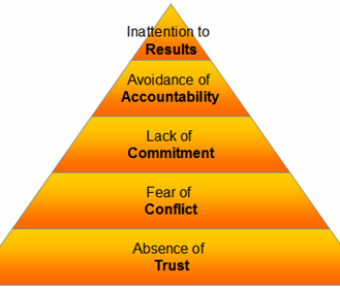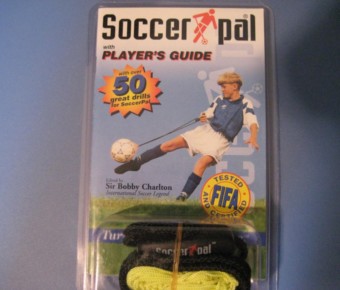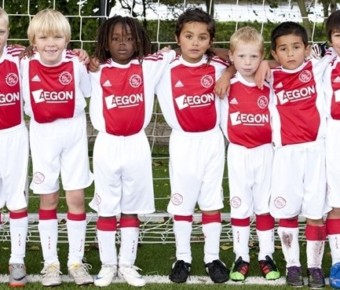What are the Five P’s?
When organising and leading my team into competition, I like to remind the players of “The 6 P’s”, an adage used throughout the British military that is designed to help you remember it’s message.
Proper Planning and Preparation Prevents Poor Performance
This ensures that all the players understand that they are preparing for something bigger and that there is something more to be aware of as they are training.
It will also help them (and me) to remember that there are 5 other P’s that are directly relevant to the team as a whole.
Passing, Possession, Position, Pace, Pressure.
Passing
The ball can move quicker than any player and the team that passes the ball quicker and more successfully will usually win the game.
The fact that football is played with your feet, means that passes on the ground are the easiest to control by your team mates and because there are 11 players on the pitch who are trying to reduce the amount of space you have to pass the ball, we can confidently say that the most likely distance for a successful pass is over (about) 10 yards (9.144 meters).
This is also a distance that everyone in our team should with practice and without opposition, be able to accurately and successfully complete 100% of the time.
I continually emphasize the point to my team, to keep passes short and to keep the ball moving as much as possible.
Possession
The ball is the most valuable item on the field, with it we can win the game, without it we cannot.
We need to ensure that when we have the ball, we make use of it to the best of our abilities and make decisions to use it in a way when factors on the field are in our favour.
It is important not to panic when we have possession and to keep the ball when we need to and move quickly to attack when the opportunity arises.
If we lose possession, we must work quickly and decisively to win possession back.
Pressure
When we have the ball, we implement pressure on the opposition by taking the ball closer to the opponents goal.
When we have the ball, we create pressure on the opposition by implementing the attacking principles of play.
I advise my team that we should play football in the opponents half, to keep possession and pass around our opposition looking for openings to score in the opponents half is the safest place to play.
To do this, it is in our best interest to take the ball to the opponents goal line (the line that runs between both corner flags AND through the goal) so that we take our opponents defenders as deep as possible, allowing us to play in even more space, in front of our opponents goal.
If the opposition does a good job of applying defensive pressure on our team, then we can release that pressure by playing back into our own half.
By doing this we are increasing the area of the pitch that we can play in. The more space there is on the field, the easier it is to keep possession.
Conversely, when we don’t have the ball, we work hard to regain posession and actively reduce the time and space that the opposition has to use the ball. If we have just lost possession to the opposition, we immediately press to win the ball back.
Position
When our opponent has the ball, we are organized to fill space on the field as decided by our teams formation.
Often players are given a set position to fill, if your team is more fluid you may ask the players that are nearest to the empty spaces that need to be filled, to fill them as quickly as possible and ask players to communicate these difference from the default positions, so that all our players understand their situation.
When our team has the ball (remember our principles of play) we must understand where we are on the field and how our position and moving from one position to another, can benefit the man with the ball. We might change our position to “create an angle” from which our team mate can pass to us.
We might also change our position to encourage the movement of a defensive player to come with us and create more space in an area of a pitch that we can exploit.
Pace
This is a requirement of individuals making passes and players timing their runs. When individuals make passes it is important that the pace and timing of the player to receive the pass is made such, that a player arrives as the ball arrives, or a has timed his run to beat the offside rule.
It is also relevant to the teams reaction as a whole, in a given situation.
For example, if our opponents have all eleven players between the ball (in our possession) and the goal, we should not as a team be too hasty to try to attack, but slow the pace of the ball in order to entice our opposition out of their defensive position. When we have successfully created space by drawing an opponent out of their defensive position, we should be ready to see the opportunity and attack with pace at the weakness.
To see this in action, have a look at Brazil v Argentina in this futsal match below. Brazil keep possession, while Argentina efficiently defend. When one Argentina defender breaks ranks and weakens their structure, Brazil swiftly take advantage:
All of these ideas echo the ideas from Michel Bruyninckx, the Academy Director at Royal Standard Liege Football Club with whom I had the chance to discuss my ideas and philosophies.
Michel told me that he liked to sumarize his ideas for his team using the acronym MAT, which expanded stands for “Movement”, “Angles” and “Timing”.
An idea that is covered in “The 5 P’s”, but is much more specific to a key area of the attacking principles.
Michel was clear to point out that he encourages players to move the ball with their first touch. This has the effect of changing all the angles on the field of play, making options for the player on the ball and forcing the opposition to react. This is one of the ways you can dictate the way your opposition plays.
We realted this little topic to the principles of attack, pointing out that “Movement”, creating “Angles” and “Timing” runs effectively as a team, encouraged Penetration, Depth, Width and Mobility (our principles of attack) , which leaves us with improvisation (effectively 1v1’s).
Michel then said something that was brilliant in it’s simplicity and will change the way I coach my players in 1v1 situations.
In a 1v1 you dribble to space, NOT to “take someone on”.
The point being made was simply this. When you are “locked down” in a 1v1 situation, you move, then your opponent must move. As a result you now have new space with which you can attack by either passing or dribbling.
The traditional idea of creating players that can do moves to “take someone on”, is flawed and ignores the simple principles of the game that have gone before a player got to his/her situation in the first place.
The game is an evolution of space and time and not a battle of one against another.










Marilee
I was rellay confused, and this answered all my questions.
Kayo
This artclie achieved exactly what I wanted it to achieve.
Keyon
Heck of a job there, it absoltuely helps me out.